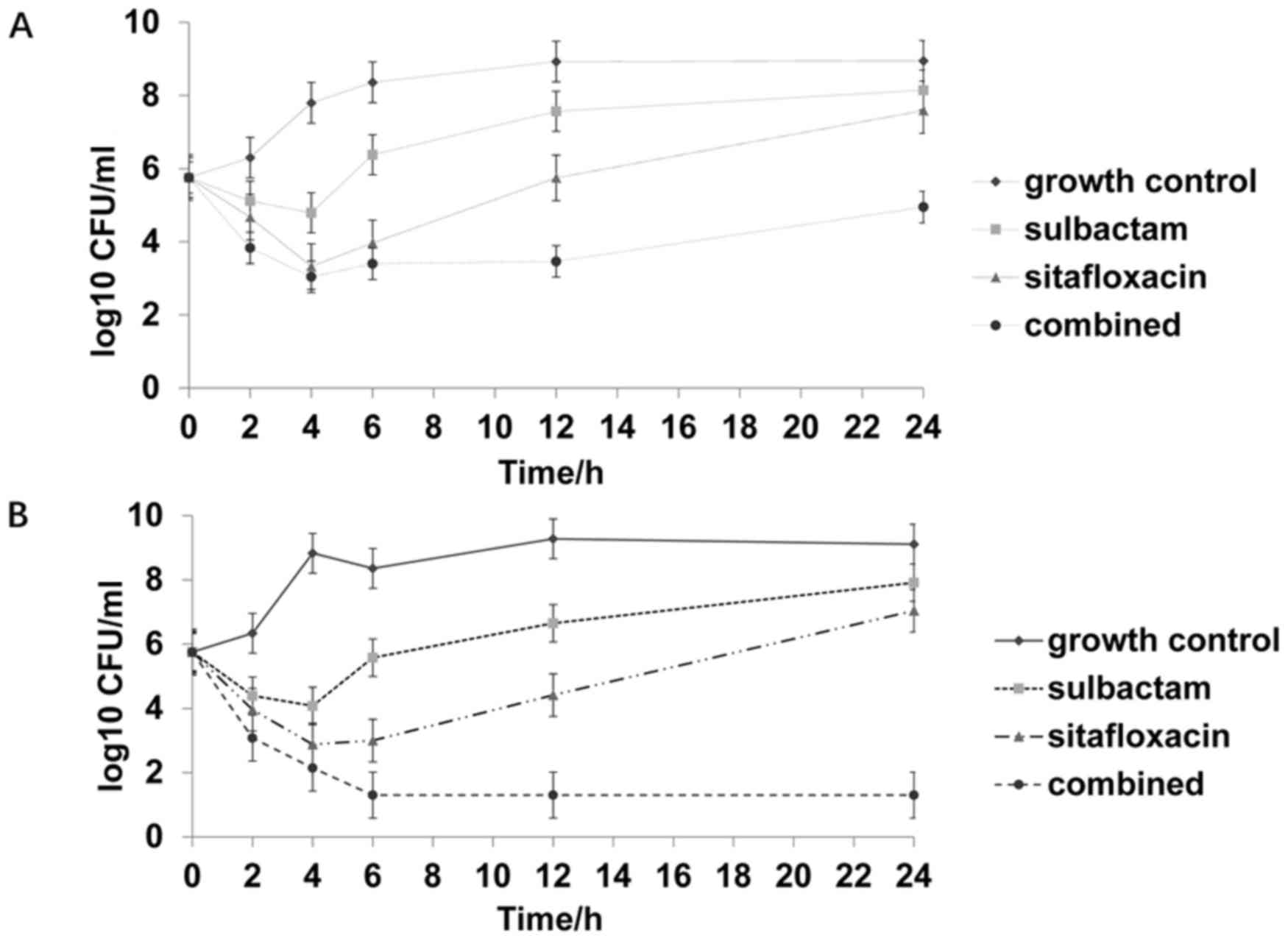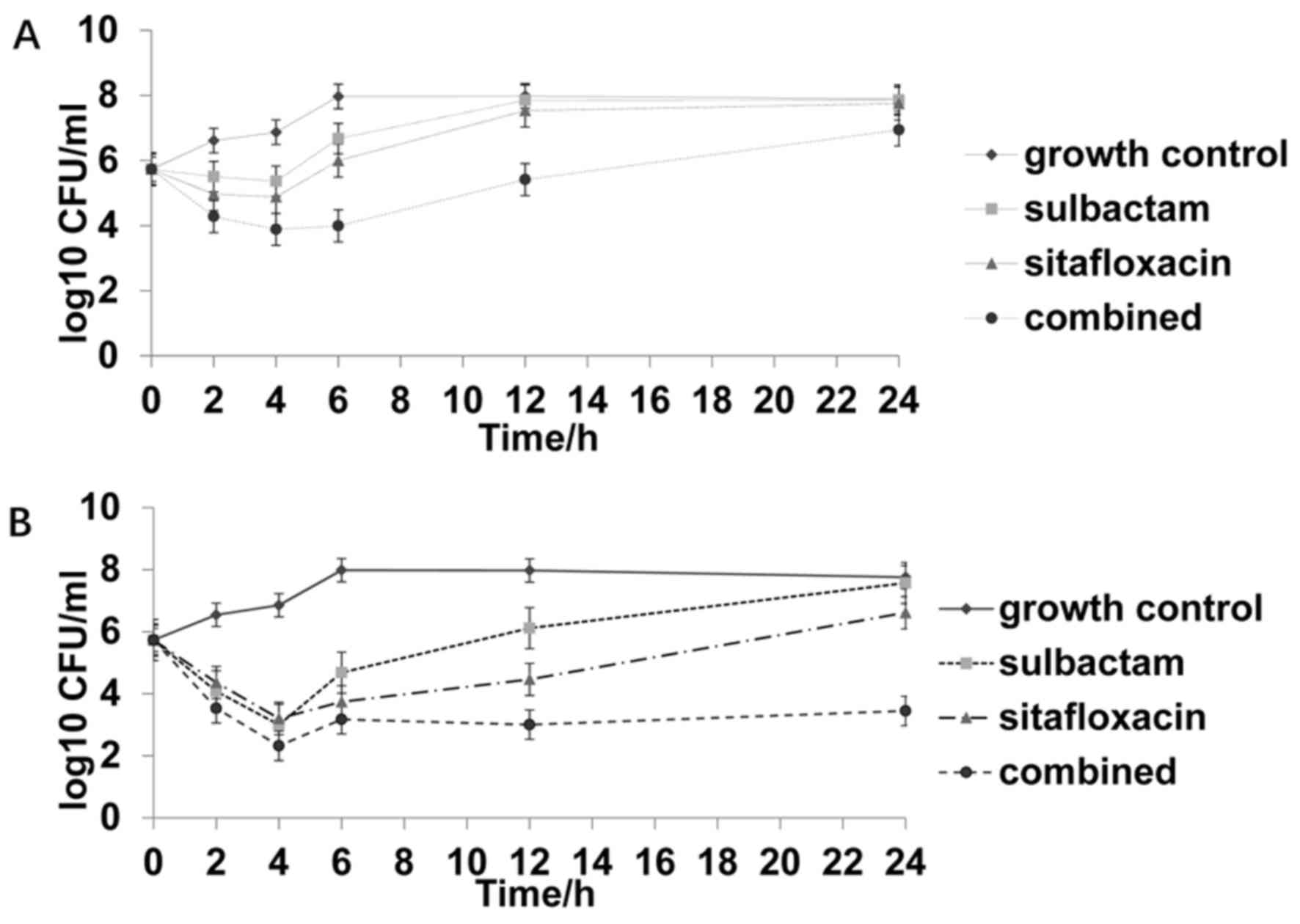|
1
|
Lee K, Yong D, Jeong SH and Chong Y:
Multidrug-resistant acinetobacter spp.: Increasingly problematic
nosocomial pathogens. Yonsei Med J. 52:879–891. 2011. View Article : Google Scholar : PubMed/NCBI
|
|
2
|
Peleg AY, Seifert H and Paterson DL:
Acinetobacter baumannii: Emergence of a successful pathogen. Clin
Microbiol Rev. 21:538–582. 2008. View Article : Google Scholar : PubMed/NCBI
|
|
3
|
Cerqueira GM and Peleg AY: Insights into
Acinetobacter baumannii pathogenicity. IUBMB Life. 63:1055–1060.
2011. View
Article : Google Scholar : PubMed/NCBI
|
|
4
|
Magiorakos AP, Srinivasan A, Carey RB,
Carmeli Y, Falagas ME, Giske CG, Harbarth S, Hindler JF, Kahlmeter
G, Olsson-Liljequist B, et al: Multidrug-resistant, extensively
drug-resistant and pandrug-resistant bacteria: An international
expert proposal for interim standard definitions for acquired
resistance. Clin Microbiol Infect. 18:268–281. 2012. View Article : Google Scholar : PubMed/NCBI
|
|
5
|
Corbella X, Montero A, Pujol M, Domínguez
MA, Ayats J, Argerich MJ, Garrigosa F, Ariza J and Gudiol F:
Emergence and rapid spread of carbapenem resistance during a large
and sustained hospital outbreak of multiresistant Acinetobacter
baumannii. J Clin Microbiol. 38:4086–4095. 2000.PubMed/NCBI
|
|
6
|
Viehman JA, Nguyen MH and Doi Y: Treatment
options for carbapenem-resistant and extensively drug-resistant
Acinetobacter baumannii infections. Drugs. 74:1315–1333. 2014.
View Article : Google Scholar : PubMed/NCBI
|
|
7
|
Chen Q, Li X, Zhou H, Jiang Y, Chen Y, Hua
X and Yu Y: Decreased susceptibility to tigecycline in
Acinetobacter baumannii mediated by a mutation in trm encoding
sam-dependent methyltransferase. J Antimicrob Chemother. 69:72–76.
2014. View Article : Google Scholar : PubMed/NCBI
|
|
8
|
Clinical and Laboratory Standards
Institute, . Performance Standards for Antimicrobial Susceptibility
Testing; Twenty-Fifth Informational Supplement. CLSI document
M100-S25. Clinical and Laboratory Standards Institute; Wayne, PA:
2015
|
|
9
|
Sader HS, Flamm RK and Jones RN:
Antimicrobial activity of daptomycin tested against gram-positive
pathogens collected in europe, latin america, and selected
countries in the asia-pacific region (2011). Diagn Microbiol Infect
Dis. 75:417–422. 2013. View Article : Google Scholar : PubMed/NCBI
|
|
10
|
Ji J, Du X, Chen Y, Fu Y, Wang H and Yu Y:
In vitro activity of sulbactam in combination with imipenem,
meropenem, panipenem or cefoperazone against clinical isolates of
Acinetobacter baumannii. Int J Antimicrob Agents. 41:400–401. 2013.
View Article : Google Scholar : PubMed/NCBI
|
|
11
|
Vidaillac C, Benichou L and Duval RE: In
vitro synergy of colistin combinations against colistin-resistant
Acinetobacter baumanniiPseudomonas aeruginosa, and klebsiella
pneumoniae isolates. Antimicrob Agents Chemother. 56:4856–4861.
2012. View Article : Google Scholar : PubMed/NCBI
|
|
12
|
Huang YS, Wang JT, Sheng WH, Chuang YC and
Chang SC: Comparative in vitro activity of sitafloxacin against
bacteremic isolates of carbapenem resistant Acinetobacter baumannii
complex. J Microbiol Immunol Infect. 48:545–551. 2015. View Article : Google Scholar : PubMed/NCBI
|
|
13
|
Chung DR, Song JH, Kim SH, Thamlikitkul V,
Huang SG, Wang H, So TM, Yasin RM, Hsueh PR, Carlos CC, et al: High
prevalence of multidrug-resistant nonfermenters in
hospital-acquired pneumonia in asia. Am J Respir Crit Care Med.
184:1409–1417. 2011. View Article : Google Scholar : PubMed/NCBI
|
|
14
|
Munoz-price LS and Weinstein RA:
Acinetobacter infection. N Engl J Med. 358:1271–1281. 2008.
View Article : Google Scholar : PubMed/NCBI
|
|
15
|
Djeribi R, Bouchloukh W, Jouenne T and
Menaa B: Characterization of bacterial biofilms formed on urinary
catheters. Am J Infect Control. 40:854–859. 2012. View Article : Google Scholar : PubMed/NCBI
|
|
16
|
Doi Y, Murray GL and Peleg AY:
Acinetobacter baumannii: Evolution of antimicrobial resistance -
treatment options. Semin Respir Crit Care Med. 36:85–98. 2015.
View Article : Google Scholar : PubMed/NCBI
|
|
17
|
Dijkshoorn L, Nemec A and Seifert H: An
increasing threat in hospitals: Multidrug-resistant Acinetobacter
baumannii. Nat Rev Microbiol. 5:939–951. 2007. View Article : Google Scholar : PubMed/NCBI
|
|
18
|
Potron A, Poirel L and Nordmann P:
Emerging broad-spectrum resistance in Pseudomonas aeruginosa and
Acinetobacter baumannii Mechanisms and epidemiology. Int J
Antimicrob Agents. 45:568–585. 2015. View Article : Google Scholar : PubMed/NCBI
|
|
19
|
Göttig S, Gruber TM, Higgins PG, Wachsmuth
M, Seifert H and Kempf VA: Detection of pan drug-resistant
Acinetobacter baumannii in germany. J Antimicrob Chemother.
69:2578–2579. 2014. View Article : Google Scholar : PubMed/NCBI
|
|
20
|
Karah N, Haldorsen B, Hermansen NO, Tveten
Y, Ragnhildstveit E, Skutlaberg DH, Tofteland S, Sundsfjord A and
Samuelsen Ø: Emergence of OXA-carbapenemase- and 16S rRNA
methylase-producing international clones of Acinetobacter baumannii
in norway. J Med Microbiol. 60:515–521. 2011. View Article : Google Scholar : PubMed/NCBI
|
|
21
|
Sharma PC, Jain A and Jain S:
Fluoroquinolone antibacterials: A review on chemistry, microbiology
and therapeutic prospects. Acta Pol Pharm. 66:587–604.
2009.PubMed/NCBI
|
|
22
|
Krzyściak P, Chmielarczyk A, Pobiega M,
Romaniszyn D and Wójkowska-Mach J: Acinetobacter baumannii isolated
from hospital-acquired infection: Biofilm production and drug
susceptibility. APMIS. 125:1017–1026. 2017. View Article : Google Scholar : PubMed/NCBI
|
|
23
|
Saroj SD, Clemmer KM, Bonomo RA and Rather
PN: Novel mechanism for fluoroquinolone resistance in Acinetobacter
baumannii. Antimicrob Agents Chemother. 56:4955–4957. 2012.
View Article : Google Scholar : PubMed/NCBI
|
|
24
|
Grochowalska A, Kozioå-Montewka M and
Sobieszczańska A: Analysis of Acinetobacter baumannii resistance
patterns in patients with chronic obstructive pulmonary disease
(copd) in terms of choice of effective empiric antibiotic therapy.
Ann Agric Environ Med. 24:307–311. 2017. View Article : Google Scholar : PubMed/NCBI
|
|
25
|
Keating GM: Sitafloxacin: In bacterial
infections. Drugs. 71:731–744. 2011. View Article : Google Scholar : PubMed/NCBI
|
|
26
|
Deguchi T, Yasuda M, Kawamura T, Nakano M,
Ozeki S, Kanematsu E, Nishino Y and Kawada Y: Improved
antimicrobial activity of DU-6859a, a new fluoroquinolone, against
quinolone-resistant klebsiella pneumoniae and enterobacter cloacae
isolates with alterations in GyrA and ParC proteins. Antimicrob
Agents Chemother. 41:2544–2546. 1997.PubMed/NCBI
|
|
27
|
Thamlikitkul V and Tiengrim S: In vitro
activity of sitafloxacin against carbapenem-resistant Acinetobacter
baumannii. Int J Antimicrob Agents. 42:284–285. 2013. View Article : Google Scholar : PubMed/NCBI
|
|
28
|
Rafailidis PI, Ioannidou EN and Falagas
ME: Ampicillin/sulbactam: Current status in severe bacterial
infections. Drugs. 67:1829–1849. 2007. View Article : Google Scholar : PubMed/NCBI
|
|
29
|
Penwell WF, Shapiro AB, Giacobbe RA, Gu
RF, Gao N, Thresher J, McLaughlin RE, Huband MD, DeJonge BL, Ehmann
DE and Miller AA: Molecular mechanisms of sulbactam antibacterial
activity and resistance determinants in Acinetobacter baumannii.
Antimicrob Agents Chemother. 59:1680–1689. 2015. View Article : Google Scholar : PubMed/NCBI
|
|
30
|
Urban C, Go E, Mariano N and Rahal JJ:
Interaction of sulbactam, clavulanic acid and tazobactam with
penicillin-binding proteins of imipenem-resistant and -susceptible
acinetobacter baumannii. FEMS Microbiol Lett. 125:193–197. 1995.
View Article : Google Scholar
|
|
31
|
Poulikakos P, Tansarli GS and Falagas ME:
Combination antibiotic treatment versus monotherapy for
multidrug-resistant, extensively drug-resistant, and
pandrug-resistant acinetobacter infections: A systematic review.
Eur J Clin Microbiol Infect Dis. 33:1675–1685. 2014. View Article : Google Scholar : PubMed/NCBI
|
|
32
|
Odds FC: Synergy, antagonism, and what the
chequerboard puts between them. J Antimicrob Chemother. 52:12003.
View Article : Google Scholar : PubMed/NCBI
|
|
33
|
Nageeb W, Metwally L, Kamel M and Zakaria
S: In vitro antimicrobial synergy studies of carbapenem-resistant
Acinetobacter baumannii isolated from intensive care units of a
tertiary care hospital in egypt. J Infect Public Health. 8:593–602.
2015. View Article : Google Scholar : PubMed/NCBI
|
|
34
|
Phee LM, Betts JW, Bharathan B and Wareham
DW: Colistin and fusidic acid, a novel potent synergistic
combination for treatment of multidrug-resistant Acinetobacter
baumannii infections. Antimicrob Agents Chemother. 59:4544–4550.
2015. View Article : Google Scholar : PubMed/NCBI
|
|
35
|
Simsek F, Gedik H, Yildirmak MT, Iris NE,
Türkmen A, Ersoy A, Ersöz M and Gücüyener A: Colistin against
colistin-only-susceptible Acinetobacter baumannii-related
infections: Monotherapy or combination therapy? Indian J Med
Microbiol. 30:448–452. 2012. View Article : Google Scholar : PubMed/NCBI
|
















